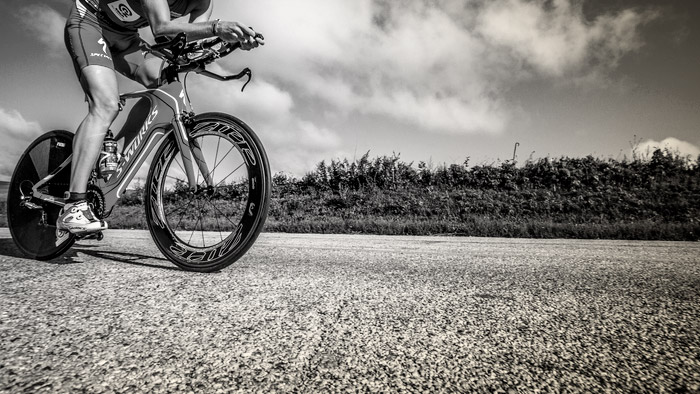Best Bike Split (BBS) is a modeling tool designed to better help cyclists plan race pacing for time trial and triathlon events. Athletes and coaches use the tool by either loading a specific course based on GPS data, or choosing from thousands of already loaded courses. Next, users put in the date and time of the race, and a number of attributes about the rider’s equipment and physical parameters ranging from height and weight to the rim width of the wheels, tire and inner tube type.
Once all of the parameters are carefully entered, the modeling algorithm pulls forecasted weather data for the location, date and time, and crunches all of the user inputted numbers, providing a nice output report that provides predictions of the following: a predicted time based on inputted projected power output, a target power output for the rider’s desired time or a predicted Training Stress Score (TSS) based on anticipated intensity and duration of the effort.
The tool can be frighteningly accurate, often yielding time predictions within seconds of actual, and wattage predictions within a couple of watts of actual. The output data can be useful in a number of applications from more intelligently setting race day goals to setting power and stress parameters for training and race day pacing.
Coefficient of Drag
As with any model, the outputs are only as good as the inputs. While all inputs are important, the biggest contributor to the success of predictions is highly attributed to one factor, Coefficient of Drag (CdA).
CdA is the quantification of the amount of resistance the wind has on the rider and anything attached to them (including the bike, wheels, helmet, clothing etc.) While there are many forces conspiring to slow riders down, CdA is by far the biggest obstacle to overcome. There are numerous books, studies, webpages and forums dedicated to the science of aerodynamics in cycling, but one refrain is consistent, aero matters, a lot. And, the rider is the biggest contributor to overall drag.
Depending on the source, roughly 70 to 90 percent of all resistance is caused by wind on the rider and bike and roughly 80 percent of that is caused by the rider alone. This being said, in the context of modeling and predictions, small errors in the inputs into CdA for the model can have significant impacts on the accuracy of the output. Being accurate with your equipment selections in the model is an easy way to contribute positively to the equation, but the biggest contributor is factoring CdA for the rider’s position which also happens to be the toughest to estimate for the layman.
Best Bike Split recognizes this and provides three methods to input total CdA. First is generalized categories based on the user’s self-assessment of how aggressive/aero their position is on the bike. The second option is direct input of CdA from wind tunnel testing data. Last, there is direct input from sophisticated fitting tools that calculates CdA.
Potential Pitfalls
Each of these is a great starting point, but can potentially come with its own issues. For example, one would think the fit and wind tunnel are the most accurate, but each of those methods deals with an ideal position held for a short period of time in a fairly sterile environment. It’s an absolute best case scenario. While the methodology outlined below is primarily meant for those who are using the generalized categories, even in cases where athletes have wind tunnel or fit produce CdAs to input into the model, I’d recommend this approach to validate your inputs especially if you are seeing inaccurate predictions.
How To Fully Validate Your CdA
The approach is to first enter all of the bike and rider data as accurately as you can based on what you have available (pro bike fit, wind tunnel or estimated position using the provided categories), and then select a course and race in the past that you have full finish metrics for (i.e. power, speed, finish time etc.). You then run the model for the actual date, time and course that the event took place on. Running the model on past events means that weather, power output and finish time now become constants instead of variables, and you can adjust other parameters to match the actual results. If you find the results are significantly off for your initial run, you can tweak CdA on several runs over the same course to match the prediction as closely as possible to the actual results. I recommend doing this by simply starting with changing the generalized categories to a more aggressive or less aggressive position vice attempting to adjust the raw values.
If you do decide to change the raw values, I would recommend up or down by no more than .01 at a time to get a sense of how small changes can impact the results. Each run of the model is very quick so making a change and then running the model again to see the impact is very quick and easy. Once you feel you have CdA dialed in for one course, you can then apply the new CdA to other courses and prior races as well. Once you are getting reliable results validating on historical runs, then you can more confidently use your newly calculated CdA for predictions.
If you don’t have historical runs, you can make your own. Take a local course and run it in full race setup a few times to get actual data, and they use the same approach described above.
Considerations
Overall, there are some cautions for using this method. First, it’s a generalized pragmatic approach and is not optimized for every yaw angle (wind direction the rider may encounter). That said, for the athlete’s I have tested this method on, the prediction data used by simply tweaking the provide category selections (and properly selecting gear) has turned out to very close to actual results with the estimated CdA. Second, if you radically changed your position or equipment then historical runs with the old position or equipment will not be trustworthy for comparison. You would need to “recalibrate” conducting new runs with the new position and gear and then validate and potentially tweak CdA again.


